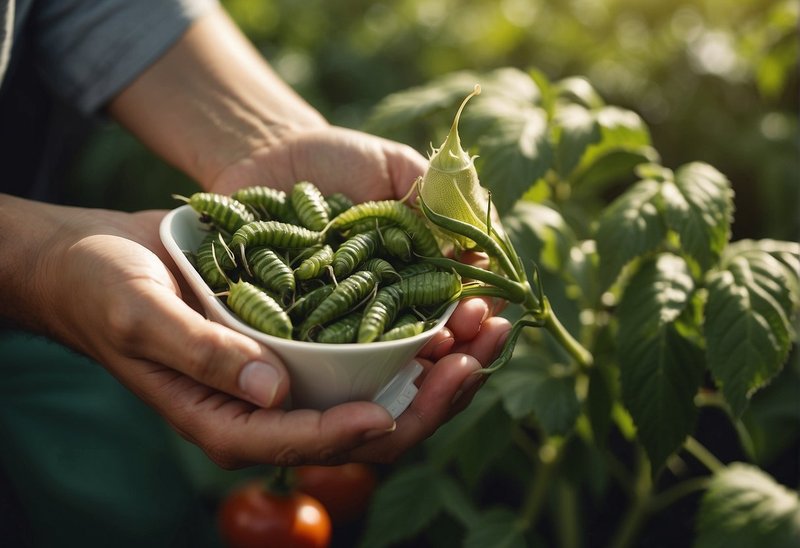
Think of your container garden like a cozy café where you serve up delicious veggies and beautiful flowers. But every café has its share of pests who want to ruin the feast. Hornworms are like those pesky customers who sneak in, munching away at the menu. In this guide, we’ll explore hornworms, how they affect container gardens, and what you can do to manage them effectively. So, pour yourself a cup of coffee, and let’s dive into the world of hornworms!
What Are Hornworms?
Hornworms are the larvae of certain moth species, primarily the **tobacco hornworm** and the **tomato hornworm**. These caterpillars are usually green, making them super sneaky among foliage, and they can grow up to 4 inches long! They get their name from the horn-like protrusion on their rear end, which gives them a unique (and slightly intimidating) look.
These little critters mostly feed on the leaves of plants in the nightshade family, including tomatoes, peppers, and eggplants—popular choices for container gardens. If you notice your plants looking a little ragged, hornworms could be the culprits. They can munch through a whole plant in just a few days, so early detection is crucial.
You might be wondering how to spot these sneaky pests. Since they blend in so well with the leaves, look for **frass** (essentially caterpillar poop), which looks like small black or green pellets, and large chunks of missing leaves. Finding them can be a challenge, but it’s a necessary step in protecting your garden.
Why Hornworms Matter in Container Gardening
In a container garden, every inch counts. Plants are often more vulnerable to pests like hornworms simply because of the limited space and resources. Unlike traditional gardens where plants have more access to nutrients and can spread out, container plants are confined, making them more susceptible to damage if a hungry hornworm comes knocking.
Moreover, container gardening often involves a variety of plants growing closely together. This dense arrangement can make it easier for hornworms to spread if they’re not managed properly. If one plant in your container garden is infested, it’s only a matter of time before the hornworms move on to their neighbors, threatening the entire setup.
Thinking about all this might feel overwhelming, but understanding hornworms’ impact will help you strategize how to protect your plants. It’s about being proactive, so you don’t have to deal with a full-blown invasion later on.
Managing Hornworms: Prevention is Key
The best way to handle hornworms is to prevent them from taking residence in your container garden in the first place. Here are some effective prevention strategies:
- Regular Inspections: Check your plants frequently for signs of hornworms. Getting into a routine can help you catch any potential problems before they escalate. Look for frass, droppings, and damaged leaves.
- Healthy Plants: Maintain the health of your plants by ensuring they have the right amount of water, sunlight, and nutrients. Strong plants can better withstand pest attacks.
- Companion Planting: Consider planting herbs and flowers that naturally repel hornworms, like marigolds and basil. They can not only deter pests but also attract beneficial insects that prey on hornworms.
By implementing these steps, you’ll create an environment that’s less inviting for hornworms and more favorable for your plants to thrive. Remember, a bit of vigilance can go a long way.
How to Identify Hornworms in Your Garden
So, you suspect you might have some hornworms in your container garden. But how can you be sure? Let’s look at some telltale signs to watch for:
1. **Damaged Leaves**: If you notice that the leaves on your plants are mysteriously disappearing, it may be time to take a closer look. Hornworms tend to start their feast from the top down, so check the uppermost leaves first.
2. **Frass**: As mentioned earlier, hornworm frass is a clear indicator of their presence. The little black or green pellets on the ground around your plants are a strong signal that something is munching away at your garden.
3. **The Caterpillars Themselves**: If you’re lucky (or unlucky, depending on how you see it), you might spot the hornworms in action. They often hide during the day, making them more challenging to find, but they do come out at night. Using a flashlight during your evening checks can help you spot them munching away.
Once you’ve identified hornworms, you’ll have to decide how to handle them. Don’t worry; you’ve got options!
Ways to Control Hornworms
Once you’ve spotted hornworms, it’s time to take action. Here are a few methods to control them in your container garden:
- Handpicking: This is the most straightforward method. Simply go out to your garden and pick off the hornworms you see. It might feel a bit gross, but it’s effective! You can drop them into soapy water to kill them.
- Organic Pesticides: If the infestation is serious, consider using organic pesticides like Bacillus thuringiensis (Bt). It specifically targets caterpillars without harming beneficial insects.
- Encourage Beneficial Insects: Ladybugs and lacewings are great allies in the battle against hornworms. They feed on a variety of pests, helping keep your garden balanced and healthy.
The key is to act quickly. The sooner you tackle the problem, the less damage your plants will suffer. Think of yourself as the protector of your garden, ready to take on any challenge that comes its way!
Benefiting From Hornworms: Nature’s Recycling Crew
While hornworms can be a nuisance, it’s fascinating to note that they are part of a larger ecosystem. In fact, they eventually turn into moths, which pollinate various plants. This means there’s a balance to maintain. If you find yourself with a few hornworms, consider how you might use them in a beneficial way.
For example, if you raise chickens, hornworms can be a tasty treat for your feathered friends. They’re packed with protein and can be a great supplement to their diet. Additionally, if you’re into composting, hornworms can also provide nutrients as they break down, enriching your compost heap.
Here’s the thing: while you want to manage their population, it’s also important to recognize their role in the garden’s ecosystem. Finding balance is key to a thriving container garden.
Final Thoughts on Hornworms in Container Gardening
Hornworms might seem scary at first, but with a little knowledge and preparation, you can keep them in check and maintain a thriving container garden. Regular inspections, combined with proactive prevention strategies, will help protect your plants from these pesky caterpillars.
Don’t forget to appreciate the role these creatures play in nature, even if they can be a pain sometimes. By understanding hornworms and how to manage them, you can ensure your container garden remains a beautiful oasis filled with healthy plants. Happy gardening!

